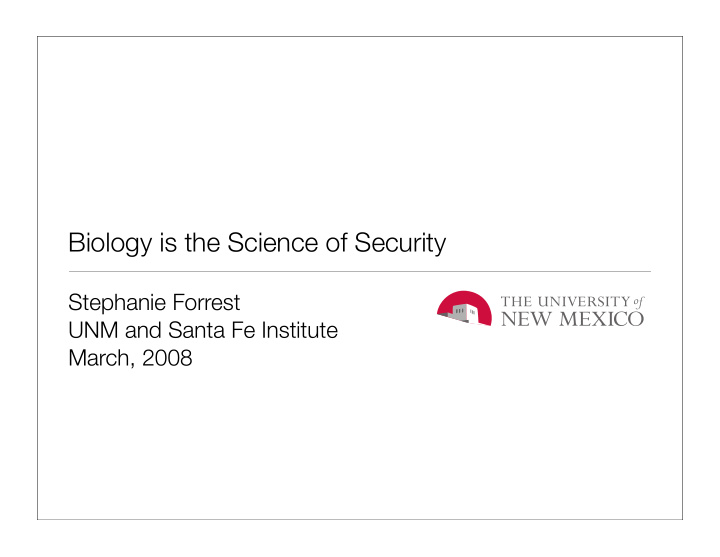



Biology is the Science of Security Stephanie Forrest UNM and Santa Fe Institute March, 2008
What can we learn from other fields? • Experimental design • How to conduct experiments and analyze results • Quantitative methods • PCA, ICA, nested models, species-abundance curves, phylogenetic tree reconstruction, power law analysis. How to evaluate results based on unfamiliar methods? Do the theorems provide insight? • Architecture, mechanisms, and principles of other complex systems • Study solutions that have been developed in other systems to problems that are similar to those we want to solve
Experiments seems obvious but ... • Conducting repeatable experiments • Articulate a clear hypothesis and design the simplest possible experiment. Allows others to confirm results and test variations • Public domain prototypes and data sets (overfitting issue) • Careful comparisons and repeatability are surprisingly difficult • Complex environments • Results often depend heavily on data inputs • Metrics that emphasize breadth of coverage and corner cases
Principles of biological computation • Traditional approach to CS: • Lessons from biology: • Decomposability and modularity • Survivability and evolvability • Explicit management of • Autonomy exceptions and interactions • Robustness, disposable • Efficiency, correctness, and components optimality • Adaptation and self repair • Diversity • The cost of getting big
Biological defense mechanisms Applied to computation • Immunology: • Protect an individual (single host or a network) against network epidemics and other forms of attack. • Antivirus programs, intrusion-detection systems • Sana Security Primary Response • Autonomic responses, e.g., homeostasis: • Tightly coupled low-level detection/response phases. • pH and network (virus) throttling. • HP’s Virus Throttle
Biological defense mechanisms Applied to computation cont. • Diversity: • Genetic diversity leads to population-level robustness. • Disrupt software monoculture using randomization and/or evolution. • Microsoft Vista Address Space Randomization • Epidemiology: • Network-based control of viruses/worms. • Focus on network topology (the epidemic threshold). • Survivability and attack resistance (PGBGP---work in progress)
Other biological defense mechanisms Still to be tapped • The innate immune system • Ecological interactions and evolutionary biology • Malware ecology: Malware interactions, indicator species, etc. • Automated bug repair using evolutionary methods • Optimal levels of defense in depth • Intracellular defenses and repair mechanisms • RNA i • Restriction enzymes
Overarching themes • What level of abstraction is appropriate? • Negative selection mechanism vs. • Automated diversity • What makes a computation biological or biologically inspired? • Architecture, mechanism, functionality • Biological principles are being discovered in bits and pieces • Need a unified framework
Science envy? • We may have made more progress than we realize • Forcing attack vectors to evolve • Why should we expect to solve the problem so that we never need to touch it again? • Biomedicine doesn’t, economics doesn’t • No simple quantitative metrics for “health”; Indicators rather than metrics? • Suggestion: “Accumulate knowledge in a systematic fashion” • It’s not only about quantitative prediction (building intuitions, existence proofs, critical regions)
Engineering practices based on principles of biology • Why do we need them? • Evolution of the software ecosystem (software rot, malware) • Dynamic, mobile, complex, and hostile environments • Moore’s Law won’t rescue us • Hallmarks • Simple and generic • Computationally and memory efficient • Automatically self-tuning, distributable, diverse, and autonomous
Recommend
More recommend